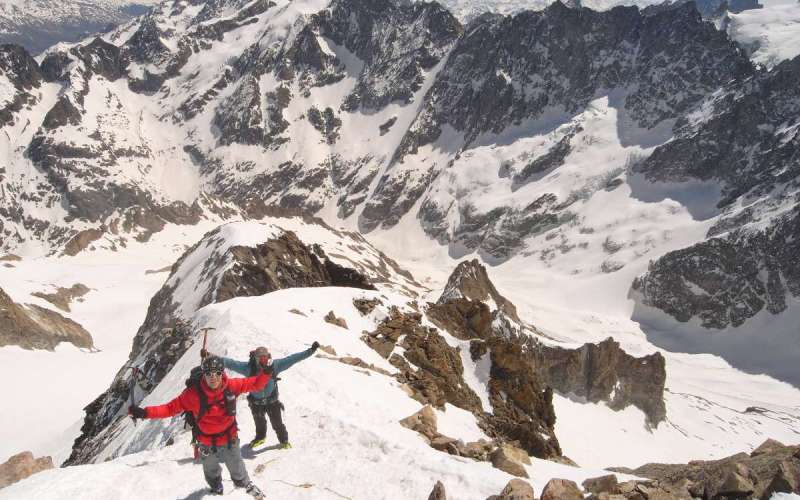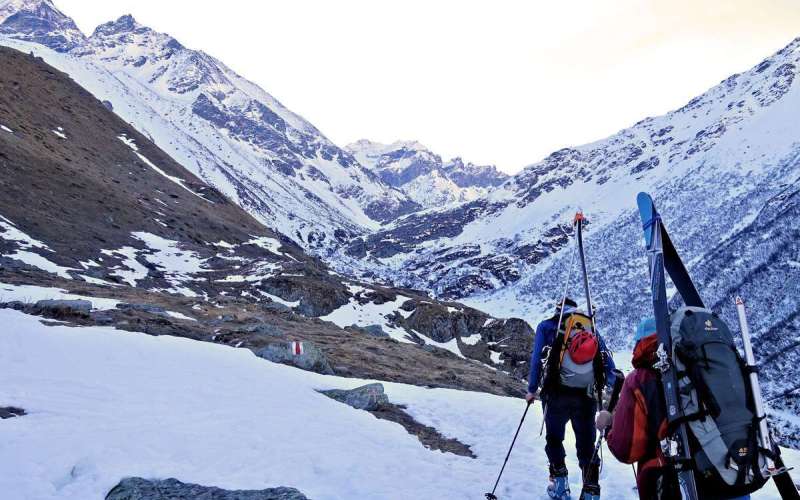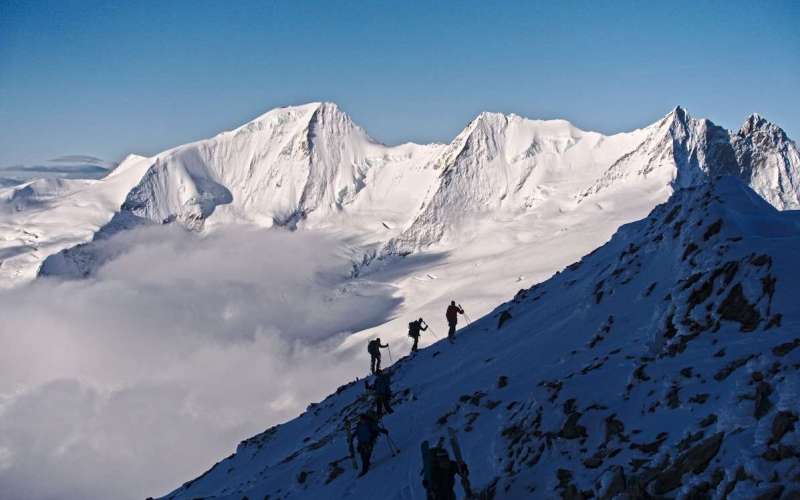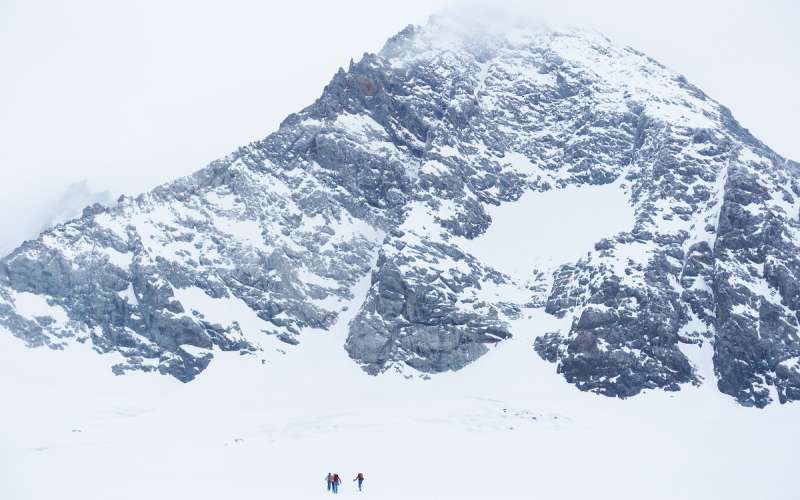Ecrins Ski Mountaineering Traverse
You are keen to bootpack steep couloirs, climb exposed ridges and ski 45° slopes? All of this on a hut-to-hut ski traverse in wild and remote terrain?
The Ecrins Ski Traverse has it all!
The Ecrins Massif is a rugged mountain range in the southwestern part of the alpine arch in the French Départment of Hautes-Alpes. Due to the steep topography and glaciers it is sometimes referred to as the "Karakorum" of the Alps. The two most iconic peaks are La Meije and Barre des Écrins, which is the southernmost alpine 4000 m peak. The dark wall of La Meije looming over La Grave might be a familiar sight to many cyclists and off-piste skiers. But as a skitouring venue the Écrins is rather unknown and reserved to only very skilled ski mountaineers.
On our skitour through the Écrins Massif we will cross numerous alpine cols, climb the few accessible peaks with skis, Dome de Neige (4015 m), Montagne des Agneaux (3664 m) and La Grande Ruine (3765 m) and ski on steep slopes and sometimes narrow gullies. In favorable conditions we will also do the Tour de la Meije, which is the ultra classic 2 day ski mountaineering journey of the region.
In sum, the Écrins Ski Traverse is the challenge ski mountaineers are looking for and a true lifetime adventure.
Individual dates for groups from 2 to 4 skiers.
Shorter and/or customized itineraries possible.
Bitte beachte unsere Infos zu den Anforderungen im Infocenter!
Itinerary
Day 0: Pre-trip meeting with your guide in our Hotel in La Grave at 7pm. The nearest Airports are Lyon, Alpes-Isère and Torino. Kit check and briefing on trip itinerary and avalanche conditions.
Day 1: We take the first gondola to Col de la Lauze (3500 m). A steep 35+ dg south facing ski descent down to Glacier de la Selle. Skins on and a short hike to Col du Replat (3300 m). Drop in secured on the rope and then a long southeast facing descent on spring snow to Refuge de Chatelleret. Vertical ↑ 500 ↓ 1750 m
Day 2: Pre-dawn start for the Col de la Casse Déserte (3483 m). Big steep slopes that require the use of ski crampons and sometimes also bootpacking. We cross over to a second col to reach the scenic Adèle Planchard Hut at 3169 m, where we spend the night. Vertical ↑ 1500 ↓ 300 m
Day 3: Casual start to the airy summit of La Grande Ruine (3765 m). We soak in the views while waiting for corn snow to be ready for our descent. Long scenic descent to Alpe Villar d’Arêne Hut. Vertical ↑ 700 ↓ 1700 m
Day 4: Long day on complex terain to one of the biggest ski summits of the range, Montagne des Agneaux (3648 m). Steep north facing descent, hopefully in powder, back to Alpe Villar d’Arêne Hut. Vertical ↑ 1700 ↓ 1700 m
Day 5: We climb to the Brèche de la Plate des Agneaux and follow the ridge towards Pic de Neige Cordier. Traverse towards Col Emile Pic (3485 m). Abbing in and some big turns on corn snow to the Refuge des Écrins. Vertical ↑ 1500 ↓ 300 m
Day 6: We follow Glacier Blanc to the foot of the mighty Barre des Écrins northface. Through big Séracs and steep slopes we wind up our way to the summit of Dome de Neige (4015 m). The descent requires care as we are skiing above big ice cliffs where a fall can be fatal. Finally, we cruise the flat glacier down to Refuge Glacier Blanc. In high avalanche danger conditions we will climb Roche Faurio (3730 m) instead. Vertical ↑ 1000 ↓ 1600 m
Day 7: We skin up to the Col de Monetier (3339 m), which takes us back to Monetier Les Bains and the spring. It's strongly recommendable to take it easy and enjoy the french cuisine and lifestyle with another night in the hotel, before tackling the long journey back home the next day. Vertical ↑ 1400 ↓ 1900 m
For those still fresh and motivated the famous Tour de la Meije would be an extension not to be missed.
Tour de la Meije Extension (additional cost please inquire here)
Prerequisites
- excellent cardiovascular fitness: stamina for 6+ hours of ascent (up to 2000 meters vertical max and average 1600 meters per day) and 2000 meter ski descents.
- excellent off-piste ski technique, controlled skiing in all types of snow, including crusts and slopes up to 40+ dg,
- solid ski mountaineering skills: kickturns, ascending with ski crampons, climbing 45 dg snow with piolet and boot crampons
- proficient use of avalanche safety equipment
- no pre-acclimatisation required
Getting There
The nearest Airports are Lyon, Alpes-Isère, Torino and Geneva. We are happy to assist in arranging your travelling.
Accommodation & Food
You will stay on typical alpine mountain huts. They have a big dining room and dormitories with usually 4–12 bunks. Sometimes the dormitories have up to 20 bunks. The sanitary conditions are basic with common toilets, washing rooms and only rare showers. On very high huts there is sometimes not even running water.
We typically have half board on the hut. A lean breakfast with bread, jam, butter and, depending on the region, cereals are served along with coffee or tea. Dinner consists of 3 to4 courses: starters / soup, sometimes salad, main course with some meat, desert. Vegetarian or other dietary requirements are accounted for.
You can order non-alcoholic drinks, beer and wine. Likewise, snacks and lunch can be purchased. On the higher huts there is no potable water and you will have to buy bottled water.
Please don't hesitate to contact us in case of questions.
Gear
Lightweight skitouring skis and -skins. Avalanche safety equipment. Full glacier travel kit.
Included
- Organization on site from the meeting point
- 7 full days guiding by a IFMGA licensed Mountain Guide from Picos
- Rental gear: glacier travel and avalanche safety kit
- All guide's expenses
Excluded
- 6 x Night/Half board on mountain huts approx. 50 €/Night (alpine club members) + 2 x Night/Half board in a hotel 70 €/Night
- Lift ticket, Taxi transfer back to starting point 120 €
- Lunch and drinks on the huts. (lunch for take away can be ordered the day before)
- personal insurance covering mountain rescue
Specials
for this trip
Flexibility: joint risk of bad (weather) conditions.
Flexibility is our working method - not a slick marketing slogan. We budget 1-2 extra days in the planning of many of our trips to factor in adverse weather conditions. The days can for example be used to move the trip a day or two as to use the best weather window for the summit bid.
Of course you only pay the actual guiding days. We'd rather achieve your goal than insist on doing a poor alternative.
Alternate dates: if it doesn't work out first try.
Ambitious alpine goals require the right conditions and this might not be the case on your first try. We understand that you don't want to hire a guide for not climbing your cherished dream route. On our individually arranged trips we discuss and agree on how to deal with this situation prior to the trip.
Understandably we cannot cancel all our trips in the high season. But we will come up with a fair deal for both sides: a prefixed alternate date, a voucher for the next attempt, an adapted rate for smaller and less committing objectives, or the option to cut off some days.
Climate protection: less babble.
Environmental protection must not be misused for mere image cultivation. Businesses who earn their money with air travel should not pat themselves on the back because they use recycled paper and green electricity. This is not credible. We clearly acknowledge the undeniable environmental damage our activities cause, and we try to at least partly offset them by the following actions, without too many words:
We encourage you to travel by train. If possible we give you a lift from the train station. We help to reduce your luggage by providing you all the technical gear required for your trip. Given a sufficient number of participants, we cover up to 50% of your train ticket.
We compensate our own as well as the CO2 emissions of our clients travelling by car without any additional cost in a transparent and comprehensive way. Of course, you are also invited to contribute. Get in touch if there are any questions!
Additional Info
and links
The itinerary as described can only be completed in top conditions and with a very fit team. Smaller group sizes can be a key factor to success. Please make an inquiry for an individual trip at a lower guiding ratio.






















